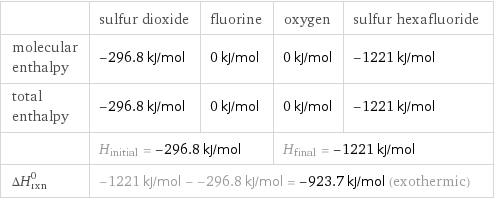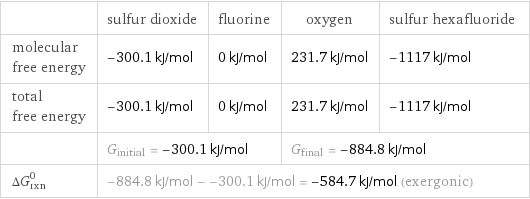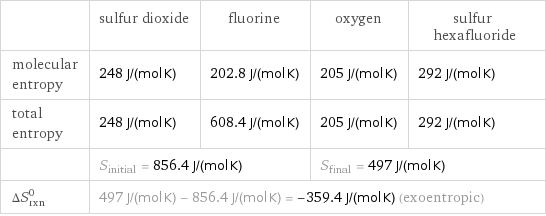Input interpretation

SO_2 sulfur dioxide + F_2 fluorine ⟶ O_2 oxygen + SF_6 sulfur hexafluoride
Balanced equation

Balance the chemical equation algebraically: SO_2 + F_2 ⟶ O_2 + SF_6 Add stoichiometric coefficients, c_i, to the reactants and products: c_1 SO_2 + c_2 F_2 ⟶ c_3 O_2 + c_4 SF_6 Set the number of atoms in the reactants equal to the number of atoms in the products for O, S and F: O: | 2 c_1 = 2 c_3 S: | c_1 = c_4 F: | 2 c_2 = 6 c_4 Since the coefficients are relative quantities and underdetermined, choose a coefficient to set arbitrarily. To keep the coefficients small, the arbitrary value is ordinarily one. For instance, set c_1 = 1 and solve the system of equations for the remaining coefficients: c_1 = 1 c_2 = 3 c_3 = 1 c_4 = 1 Substitute the coefficients into the chemical reaction to obtain the balanced equation: Answer: | | SO_2 + 3 F_2 ⟶ O_2 + SF_6
Structures

+ ⟶ +
Names

sulfur dioxide + fluorine ⟶ oxygen + sulfur hexafluoride
Reaction thermodynamics
Enthalpy

| sulfur dioxide | fluorine | oxygen | sulfur hexafluoride molecular enthalpy | -296.8 kJ/mol | 0 kJ/mol | 0 kJ/mol | -1221 kJ/mol total enthalpy | -296.8 kJ/mol | 0 kJ/mol | 0 kJ/mol | -1221 kJ/mol | H_initial = -296.8 kJ/mol | | H_final = -1221 kJ/mol | ΔH_rxn^0 | -1221 kJ/mol - -296.8 kJ/mol = -923.7 kJ/mol (exothermic) | | |
Gibbs free energy

| sulfur dioxide | fluorine | oxygen | sulfur hexafluoride molecular free energy | -300.1 kJ/mol | 0 kJ/mol | 231.7 kJ/mol | -1117 kJ/mol total free energy | -300.1 kJ/mol | 0 kJ/mol | 231.7 kJ/mol | -1117 kJ/mol | G_initial = -300.1 kJ/mol | | G_final = -884.8 kJ/mol | ΔG_rxn^0 | -884.8 kJ/mol - -300.1 kJ/mol = -584.7 kJ/mol (exergonic) | | |
Entropy

| sulfur dioxide | fluorine | oxygen | sulfur hexafluoride molecular entropy | 248 J/(mol K) | 202.8 J/(mol K) | 205 J/(mol K) | 292 J/(mol K) total entropy | 248 J/(mol K) | 608.4 J/(mol K) | 205 J/(mol K) | 292 J/(mol K) | S_initial = 856.4 J/(mol K) | | S_final = 497 J/(mol K) | ΔS_rxn^0 | 497 J/(mol K) - 856.4 J/(mol K) = -359.4 J/(mol K) (exoentropic) | | |
Equilibrium constant
![Construct the equilibrium constant, K, expression for: SO_2 + F_2 ⟶ O_2 + SF_6 Plan: • Balance the chemical equation. • Determine the stoichiometric numbers. • Assemble the activity expression for each chemical species. • Use the activity expressions to build the equilibrium constant expression. Write the balanced chemical equation: SO_2 + 3 F_2 ⟶ O_2 + SF_6 Assign stoichiometric numbers, ν_i, using the stoichiometric coefficients, c_i, from the balanced chemical equation in the following manner: ν_i = -c_i for reactants and ν_i = c_i for products: chemical species | c_i | ν_i SO_2 | 1 | -1 F_2 | 3 | -3 O_2 | 1 | 1 SF_6 | 1 | 1 Assemble the activity expressions accounting for the state of matter and ν_i: chemical species | c_i | ν_i | activity expression SO_2 | 1 | -1 | ([SO2])^(-1) F_2 | 3 | -3 | ([F2])^(-3) O_2 | 1 | 1 | [O2] SF_6 | 1 | 1 | [SF6] The equilibrium constant symbol in the concentration basis is: K_c Mulitply the activity expressions to arrive at the K_c expression: Answer: | | K_c = ([SO2])^(-1) ([F2])^(-3) [O2] [SF6] = ([O2] [SF6])/([SO2] ([F2])^3)](../image_source/cd0f7942603352edff56b93f0d5ef425.png)
Construct the equilibrium constant, K, expression for: SO_2 + F_2 ⟶ O_2 + SF_6 Plan: • Balance the chemical equation. • Determine the stoichiometric numbers. • Assemble the activity expression for each chemical species. • Use the activity expressions to build the equilibrium constant expression. Write the balanced chemical equation: SO_2 + 3 F_2 ⟶ O_2 + SF_6 Assign stoichiometric numbers, ν_i, using the stoichiometric coefficients, c_i, from the balanced chemical equation in the following manner: ν_i = -c_i for reactants and ν_i = c_i for products: chemical species | c_i | ν_i SO_2 | 1 | -1 F_2 | 3 | -3 O_2 | 1 | 1 SF_6 | 1 | 1 Assemble the activity expressions accounting for the state of matter and ν_i: chemical species | c_i | ν_i | activity expression SO_2 | 1 | -1 | ([SO2])^(-1) F_2 | 3 | -3 | ([F2])^(-3) O_2 | 1 | 1 | [O2] SF_6 | 1 | 1 | [SF6] The equilibrium constant symbol in the concentration basis is: K_c Mulitply the activity expressions to arrive at the K_c expression: Answer: | | K_c = ([SO2])^(-1) ([F2])^(-3) [O2] [SF6] = ([O2] [SF6])/([SO2] ([F2])^3)
Rate of reaction
![Construct the rate of reaction expression for: SO_2 + F_2 ⟶ O_2 + SF_6 Plan: • Balance the chemical equation. • Determine the stoichiometric numbers. • Assemble the rate term for each chemical species. • Write the rate of reaction expression. Write the balanced chemical equation: SO_2 + 3 F_2 ⟶ O_2 + SF_6 Assign stoichiometric numbers, ν_i, using the stoichiometric coefficients, c_i, from the balanced chemical equation in the following manner: ν_i = -c_i for reactants and ν_i = c_i for products: chemical species | c_i | ν_i SO_2 | 1 | -1 F_2 | 3 | -3 O_2 | 1 | 1 SF_6 | 1 | 1 The rate term for each chemical species, B_i, is 1/ν_i(Δ[B_i])/(Δt) where [B_i] is the amount concentration and t is time: chemical species | c_i | ν_i | rate term SO_2 | 1 | -1 | -(Δ[SO2])/(Δt) F_2 | 3 | -3 | -1/3 (Δ[F2])/(Δt) O_2 | 1 | 1 | (Δ[O2])/(Δt) SF_6 | 1 | 1 | (Δ[SF6])/(Δt) (for infinitesimal rate of change, replace Δ with d) Set the rate terms equal to each other to arrive at the rate expression: Answer: | | rate = -(Δ[SO2])/(Δt) = -1/3 (Δ[F2])/(Δt) = (Δ[O2])/(Δt) = (Δ[SF6])/(Δt) (assuming constant volume and no accumulation of intermediates or side products)](../image_source/5fbc6ccc069f5ab8e57cbd85599805c9.png)
Construct the rate of reaction expression for: SO_2 + F_2 ⟶ O_2 + SF_6 Plan: • Balance the chemical equation. • Determine the stoichiometric numbers. • Assemble the rate term for each chemical species. • Write the rate of reaction expression. Write the balanced chemical equation: SO_2 + 3 F_2 ⟶ O_2 + SF_6 Assign stoichiometric numbers, ν_i, using the stoichiometric coefficients, c_i, from the balanced chemical equation in the following manner: ν_i = -c_i for reactants and ν_i = c_i for products: chemical species | c_i | ν_i SO_2 | 1 | -1 F_2 | 3 | -3 O_2 | 1 | 1 SF_6 | 1 | 1 The rate term for each chemical species, B_i, is 1/ν_i(Δ[B_i])/(Δt) where [B_i] is the amount concentration and t is time: chemical species | c_i | ν_i | rate term SO_2 | 1 | -1 | -(Δ[SO2])/(Δt) F_2 | 3 | -3 | -1/3 (Δ[F2])/(Δt) O_2 | 1 | 1 | (Δ[O2])/(Δt) SF_6 | 1 | 1 | (Δ[SF6])/(Δt) (for infinitesimal rate of change, replace Δ with d) Set the rate terms equal to each other to arrive at the rate expression: Answer: | | rate = -(Δ[SO2])/(Δt) = -1/3 (Δ[F2])/(Δt) = (Δ[O2])/(Δt) = (Δ[SF6])/(Δt) (assuming constant volume and no accumulation of intermediates or side products)
Chemical names and formulas

| sulfur dioxide | fluorine | oxygen | sulfur hexafluoride formula | SO_2 | F_2 | O_2 | SF_6 Hill formula | O_2S | F_2 | O_2 | F_6S name | sulfur dioxide | fluorine | oxygen | sulfur hexafluoride IUPAC name | sulfur dioxide | molecular fluorine | molecular oxygen |